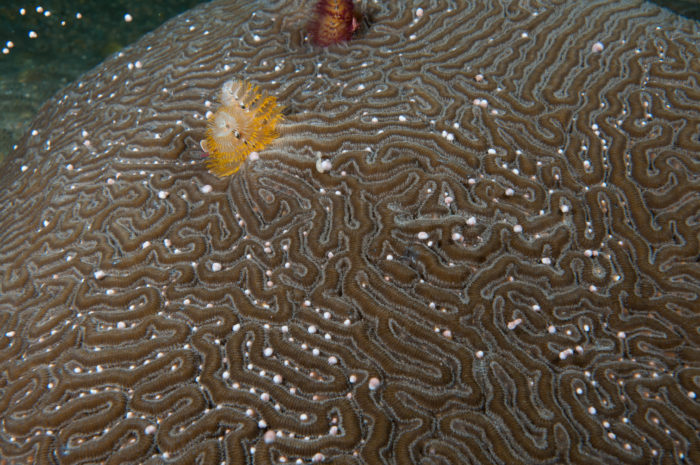
Sea Wonder: Brain Coral

Photo credit: G.P. Schmahl/FGBNMS
Who knew coral could be so brilliant? Learn about brain coral in this week’s Sea Wonder!
Appearance
Brain coral (a type of stony coral) is the common name for a number of coral species in the Mussidae and Merulinidae families, and they look like, well, brains! They are usually oblong in shape and have grooved surfaces that resemble the human brain. While you may think one brainy structure is one coral, these organisms are actually numerous communities of coral polyps that share one skeleton made of calcium carbonate. The polyp tissue is soft and houses zooxanthellae, algae that give these corals their coloration, which ranges from a brown or yellow to brighter colors – and some brain corals even glow under UV light!
Habitat and Diet
Brain corals live in shallow, warm-water reefs around the world, including in Florida Keys and Flower Garden Banks national marine sanctuaries. They need to be in shallow, clear, and warm waters to allow the symbiotic algae (plants) that live within each coral polyp to perform photosynthesis (the process of making food from sunlight and carbon dioxide).
Brain corals are filter feeders that catch small organisms drifting through the water, and also get essential nutrients from the zooxanthellae they protect. As a byproduct, the coral polyps produce calcium carbonate and build out their large skeleton.
Life History
Corals are related to jellyfish and anemones. Some corals reproduce asexually, but many stony corals spawn in large, synchronized events where colonies release millions of sperm and eggs into the water column at the same time (usually related to environmental cues like a lunar cycle, temperature, or length of daylight). The gametes join together to form larvae called planulae that float along with the ocean’s currents until they eventually settle. Between fertilization and settlement, many planulae don’t make it to adulthood due to predation, but once they settle and begin to form colonies and then reefs (which takes a long time, but it’s worth the wait), they can grow to be more than six feet in height and reach ages up to 900 years old!
Threats and Conservation
Brain corals are some of the most plentiful coral in the ocean, making them a species of least concern. However, just because they are plentiful and hearty, doesn’t mean they are immune from threats like physical damage, bleaching, ocean acidification, a warming ocean, or pollution and debris. It’s important that we make individual choices and support policies that protect coral reefs, because in addition to being beautiful (and great spots for snorkeling, diving, and fishing!), they provide protection from forces like hurricane storm surges and erosion, provide habitat to many of the world’s fish species, and produce compounds used to make medicine.
